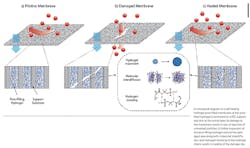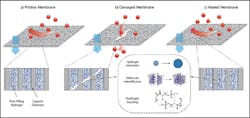AS THE PROBLEMS associated with water scarcity and declining water quality become more apparent in some parts of the county, water reuse is becoming an increasingly common option for communities to augment their water supplies. Water reuse is also becoming a more widespread option for managing wastewater rather than simply discharging into a surface water body. As water reuse becomes more common, the use of membranes has become more mainstream, acting as a physical barrier for pathogens and other chemical compounds of interest. However, a major issue regarding membranes is their long-term integrity and the cost of cleaning and continually monitoring membrane performance to ensure proper operations. Ideally, membranes would be resilient to challenges to integrity and be able to recover from damages.
Recently, there has been advancement in self-healing materials in structural, coating, and biomedical research applications. An upcoming research project being led by Dr. Jaehong Kim of Yale University and funded by the Water Research Foundation, Self-Healing Hydrogel-Composite Membranes: From Proof of Concept to Water Reuse Application, aims to build on these advances to develop self-healing membranes for use in water reuse applications. If successful, this would allow the use of membranes with less need for ongoing maintenance and integrity monitoring. This may also allow for water reuse to be practiced in locations where long-term maintenance of membranes may be a hindrance to application due to financial or technical capacity constraints.
The current generation of membranes that are being used are only operational as long as the integrity of the membrane is preserved over time. This is generally done through continuous monitoring and developing new methods of detecting membrane damage. However, current monitoring techniques can be costly and cannot currently locate the exact location of a breach, not to mention repairing a breach. Such monitoring can be especially difficult for decentralized treatment systems or small systems that may not have the capacity for traditional monitoring and maintenance protocols. By developing membranes that are more resilient to damage, there may be less need for monitoring and ongoing maintenance. This may allow small and decentralized systems to still utilize membrane-based treatment and maintain a level of assurance in the quality of treatment that is being provided.
The concept of “self-healing” commonly refers to the property of a material to restore its original properties after being damaged. Self-healing materials have been developed before, but many of these materials require outside stimulus such as heat, light, or pH changes for the self-healing properties to take effect. In addition, many self-healing materials are sensitive to moisture. For obvious reasons, these are all properties that would preclude self-healing materials from being used in a water treatment application, so further innovation is needed.
For this upcoming research, hydrogels are being investigated which do not have the same limitations. Hydrogels are materials that can absorb large amounts of water and swell to a high degree while maintaining their structure. In the context of membranes, they can create a barrier to foulant disruption that may plague other types of membranes and may have the potential to reduce fouling of membranes. The hydrogel network size within a membrane can be used as a sieve to reject solutes while allowing water to pass through. In addition to their own self-healing property, hydrogels have been used to impart self-healing to composite materials. In such cases, the swelling ability of hydrogels is usually the mechanism of healing.
Previous research led by Dr. Kim developed first-generation hydrogel pore-filled membranes that show promising self-healing properties. Early testing shows that the membranes can completely restore their rejection of 50 nanometer (nm) particles from values as low as 30% from physical damage. It is the goal of this upcoming research to take this work to the next stage by developing practical next-generation membranes for water treatment that can self-heal. Such a breakthrough would potentially reduce the cost of integrity monitoring and membrane replacement in large-scale water reuse/reclamation systems. This will be accomplished by evaluating the performance of the first-generation membranes under a range of conditions and make improvements to potentially speed up technology transfer to the broader water treatment industry.
The first phase of this project will be to optimize the properties of the hydrogel used in the membranes. The key here will be balancing the desired self-healing properties while maintaining proper rejection of solutes. In general, properties in hydrogels that support the highest self-healing ability may reduce the long-term stability of the hydrogel layer. On the other hand, properties that may enhance long-term stability may exhibit poor rejection of solutes. Finding the balance of these properties, and others, is key to advance such membranes eventually into wider use and acceptance. Additional phases of the project will look into applying this work into methods to improve the permeability of composite membranes and their self-healing properties.
Finally, this project will seek to validate the chemical and physical stability of such membranes that will be crucial to practical application. This will be accomplished through exposure to hypochlorite solution and self-healing tests. Additionally, resistance to fouling will be tested by filtering natural organic matter as well as samples from the Southern Nevada Water Authority. The long-term stability of the membranes will also be investigated with experiments to determine the effects of repeated damage to a membrane.
When complete, the outcomes of the research are expected to be potential fabrication parameters for self-healing membranes along with their expected permeability and selectivity values. While it may be a bit of time until self-healing membranes are commercially available, it is hoped that this research will be a step in moving this process forward. If such membranes can be validated and manufactured in a cost-effective manner, they may have the potential to be a viable option for small and decentralized systems that may not have the resources to utilize traditional membranes. This research represents a crucial step in the process, and this project is expected to be completed in 2019.

